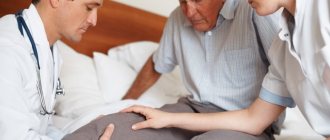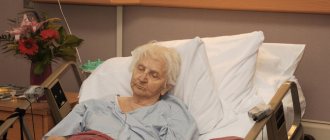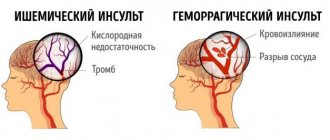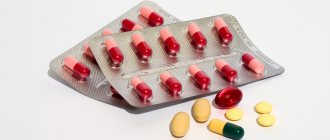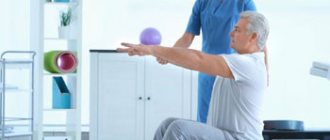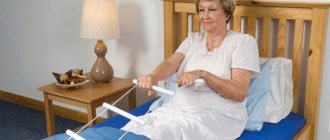First of all, you need to take into account the general physical condition of the person, the severity of symptoms and the degree of brain damage. Only a doctor can evaluate this. The condition directly depends on the duration of the attack, the time during which blood circulation in the brain was disrupted. If you seek medical help at the first signs of a stroke, this will simplify rehabilitation and increase the chances of restoring a person’s health.
A slight decrease in motor activity is a condition characteristic of cases of ischemic stroke, when assistance was provided as soon as possible and damage to brain tissue was minimized. This condition is characterized by the following symptoms: Deterioration of fine motor skills on one side of the body - decreased mobility of fingers and facial muscles; Slight deterioration in diction - lisp, stuttering and other deviations; Mild or complete memory impairment. This is the easiest option. In this condition, special care for a sick relative is reduced to almost a minimum. But connivance will not lead to good. It is mandatory to perform special physical exercises prescribed as part of the physiotherapeutic recovery program. It is necessary to adhere to a diet that excludes heavy and harmful foods. And, of course, it is imperative to follow the doctor’s instructions for taking medications aimed at preventing a recurrence of the disease. This condition is reversible with the right approach. If you follow the instructions of specialists, you can restore your health in a relatively short period of time.
What is a stroke
During a stroke, normal blood circulation in the brain is disrupted. Often the pathology develops without any noticeable preconditions, quite suddenly. The patient’s general condition worsens, cell damage occurs in the brain, which often leads to irreversible processes in the body or even death.
What are the causes of stroke? Doctors mainly highlight changes in blood composition (the appearance of blood clots, embolism) and atherosclerosis.
In sources, a description of the disease is first found in the works of Hippocrates. Later, the Greek surgeon Galen (200s AD) called this pathological condition apoplexy.
During an attack, control over areas of the brain that are responsible for certain body functions is lost.
We recommend
“Diapers for adults: sizes, absorbency and other characteristics” More details
It is extremely difficult to completely neutralize the consequences of a stroke; it depends on many factors. It is important to monitor your health and body signals.
Who is at risk? As a rule, these are men over 50, people suffering from obesity, diabetes, diseases of the cardiovascular system, alcohol abusers, smokers, drug addicts.
Stroke is associated with damage to the blood vessels of the brain and narrowing of the lumen in them. What are the causes of this pathology?
- Atherosclerosis or cholesterol plaques on the walls of blood vessels.
- Diabetes mellitus types I and II, hormonal changes.
- Use of nicotine, drugs and improper use of medications.
- Sedentary lifestyle, lack of mobility, stress.
- Taking antibiotics and oral contraceptives in combination with alcohol.
- Old age and the associated wear and tear of the tissues of the heart and blood vessels, their fragility, spasms.
One of the main and most common causes of stroke is high blood pressure. Typically, people with high blood pressure are more at risk; 70% of strokes occur in people with high blood pressure (more than 140 over 90). Problems in the functioning of the heart provoke the formation of blood clots, which, in turn, lead to strokes.
Recommended articles on this topic:
- Features of older people: psychological and physiological
- The main problems of older people and ways to solve them
- Boarding home for the elderly: features and rules of choice
How to recognize a stroke and provide first aid
In order not to miss precious time during an attack, you need to know the main signs of a stroke:
- loss of consciousness or state of “stupefaction”;
- drowsiness or sudden agitation;
- rapid heartbeat and dizziness;
- increased sweating, nausea, and in some cases vomiting;
- possible disturbance of orientation in space;
- visual disturbances, loss of sensitivity, articulation disorders.
We recommend
“How to care for a bedridden elderly person” More
You should know how to confirm a possible stroke, even without being a doctor. To do this, you need to carry out a number of tests:
- Ask the person suspected of having a stroke to raise their hands, palms up. If it's really a punch, one arm will go up correctly and the other will swing out to the side or stay down.
- Invite the person to raise both arms up at the same time. During an attack, your arms will rise at different speeds and to different heights.
- Let the patient stick out his tongue. In the event of a stroke, it will be bent or twisted to the side.
- Ask them to say a phrase. During a stroke, a person will speak as if drunk, and articulation may be impaired.
- Ask the patient to smile and show his teeth. An asymmetrical, crooked smile is a sign of a stroke.
If you see any of the above signs, immediately call an ambulance or take the person to the doctor. The correct sequence of actions and quick reaction in the event of a stroke will help reduce the sad consequences of the attack and increase the chances of the most positive outcome. How should you behave in such a situation?
- Try to remain calm and do everything so that the patient does not get nervous; do not rush around and wring your hands: this will not bring any results.
- If you can, measure the pressure, check the patient’s pulse, his breathing.
- Identify the signs of a stroke: facial asymmetry, curved tongue, speech problems, lack of coordination.
- Call an ambulance.
- Lay the patient on his back or side, slightly raising his head and torso, or horizontally. If signs of nausea occur, turn your head to the side.
- Provide first aid if necessary; if there is no breathing, the heartbeat is weak, the pupils are dilated, perform simple resuscitation measures (artificial respiration, chest compressions).
- Open the windows, unbutton your shirt, unbutton your belt - let nothing interfere with the access of oxygen.
- Observe what happens to the patient, what changes in his condition.
We recommend
“Gymnastics for the elderly: the best exercises for various diseases” More
According to statistics, if you bring a patient with signs of a stroke in the first three hours after their appearance to a medical institution, where he will receive proper care, then:
- in 50–60% of cases, patients with severe forms of stroke survive;
- in 75–90% of cases, patients who have suffered a mild form of it recover completely;
- in 60–70% of cases, the abilities of brain cells are completely restored.
Time is the most valuable resource in a stroke situation. To prevent serious brain damage, it is important to act quickly and not panic. If help is provided to the patient in a timely manner, then there is every chance of his recovery and normal life in the future.
Prevention of recurrent stroke in the elderly
There is a high risk of complications if no preventative measures are taken. The likelihood of a second attack increases tenfold, and statistics say that in 70% it ends in the death of the patient.
To avoid relapse you need:
- take medications that strengthen the walls of blood vessels;
- reduce blood viscosity by taking anticoagulants;
- reduce high cholesterol;
- do not drink alcohol, do not smoke, maintain normal weight;
- the daily routine should include light physical activity;
- if necessary, increase the functionality of blood vessels through surgery.
To effectively combat other complications of stroke, a set of measures has been developed, the quality of which determines the patient’s recovery and his further well-being.
1. Medicines to keep blood pressure levels under control. They improve blood supply function and saturate the blood with vital oxygen. Since a stroke kills cells and they cannot be restored, the main task is to prevent complications and prevent a recurrence.
If the patient is deeply depressed, antidepressants are prescribed. Anticonvulsants are taken to stop seizures, and muscle relaxants are taken to relieve muscle tone.
Anticoagulants and antiplatelet agents are the main medications that help avoid relapse of the disease.
During the recovery period, chronic diseases may worsen. To prevent this from happening, vitamins are taken as preventative measures to maintain immunity. If there is a lack of oxygen, doctors prescribe nootropics that help restore attention and memory.
2. Non-drug treatment. These include physical therapy, physiotherapeutic sessions, and therapeutic massage. Stressful situations, excessive workload, drinking alcohol and smoking are unacceptable. Medicines must be taken strictly on time.
3. Active communication with a bedridden elderly person, during which it is necessary to be tolerant of his possible fears, grievances, and irritability. The patient is weakened not only physically, but also morally, so it is especially important for him to know that he is loved.
We recommend
“Low blood pressure in older people: causes, symptoms and treatment” Read more
Care for bedridden patients after a stroke in a hospital
In a medical institution, nurses provide care for bedridden patients after a stroke. They ensure that IVs are placed and patients take medications, carry out special procedures, feed, change linen, and change clothes.
In addition, care includes the prevention of bedsores, thromboembolic complications, pulmonary congestion, and contractures. Rehabilitation measures must be started as early as possible (of course, taking into account the severity of the person’s condition), even if the patient is bedridden. Early activation can help the rapid formation of compensatory mechanisms and even the disappearance of manifestations of the disease.
We recommend
“Boarding home for the elderly: how to place an elderly relative there” More details
A bedridden patient is unable to take care of himself. Such patients need help with the simplest things: feeding, changing clothes, combing. Daily hygiene procedures even more require assistance. Washing your face, brushing your teeth, wiping your body, and washing your face are done daily, and your hair is washed once a week. It is important to dry your head well and wipe all areas of the body dry with a towel, paying special attention to the folds of the skin. In addition, to prevent diaper rash, special creams are used.
To avoid constipation in the patient, it is necessary to monitor the quality of the intestines: a large amount of fluid and fiber consumed, as well as exercise, will help prevent the negative consequences of paralysis. If a bedridden patient is unable to urinate on his own, a catheter is placed; in addition, adult diapers may be used in the hospital.
Increased attention should be paid to the prevention of complications: bedsores, venous thrombosis, muscle contractures, congestive pneumonia.
Diet
Comprehensive care for paralyzed patients includes proper balanced nutrition. Liquid pureed food is prepared for the patient so that it is not difficult for him to swallow it (jelly, grated soups, porridge, kefir). The food is given warm, in small portions (a teaspoon), with a napkin placed under the chin. A blender can be used as a chopper.
If the patient cannot swallow independently, a nasal-gastric tube is used. After feeding, it is washed with boiled warm water and its end is tightly closed.
A paralyzed patient should be fed at least 4-5 times a day. A single serving of food should be about 400 mg. The total volume of liquid per day should be at least 1.5-2 liters.
Diet features
- include boiled poultry, beef, vegetables, cereals and fruits in your diet.
- exclude salt and seasonings;
- minimize bread and pasta;
- exclude coffee, cocoa, fried and smoked foods, soda and store-bought juices.
How to care for a bedridden patient after a stroke at home
It is ideal if a bedridden patient after a stroke undergoes rehabilitation in a hospital under the supervision of professionals. But such care is available to only a few, because it costs a lot. Therefore, most victims of the disease have to recover at home, where they are looked after by relatives or special caregivers.
The vast majority of people who have suffered a stroke have problems with motor activity. This may be paralysis of one half of the body. But, unfortunately, often victims remain completely incapacitated and helpless. Caring for a bedridden patient after a stroke at home requires time, attention and effort.
Such patients are slow, and it is quite difficult for them to perform any actions. Therefore, relatives must be patient and understanding. It is very important to carry out all rehabilitation measures carefully and efficiently; the overall outcome of the disease depends on this. Manipulations included in caring for a bedridden patient:
1. Regularly change the patient’s position.
A bedridden patient should not be in one position for more than 2–3 hours; it is necessary to change his position, even if he is paralyzed. This is part of the treatment procedures.
How to position a patient:
- On the back. In this case, the paralyzed arm and leg should be placed on pillows so that the hand and foot do not hang down. It is important to place the shoulders and hip joints at the same level. The head should not bend at the cervical spine.
- On the healthy side. Paralyzed limbs are also placed on pillows in front. The leg is bent at the knee and hip joint.
- On the sore side. You should not allow yourself to fall on your stomach. The affected arm should be slightly brought forward, the healthy arm should be slightly to the side or behind the back. The paralyzed leg should be straightened at the hip joint, but can be bent at the knee. The healthy leg, bent at both joints, is brought forward and laid out on a pillow.
You need to make sure that your feet do not rest against the headboard of the bed, and that the postures are not unnatural and uncomfortable. In addition, there are now devices that can alleviate the condition of a paralyzed person and at the same time have a therapeutic effect.
2. Proper organization of feeding.
A bedridden patient after a severe stroke often cannot eat on his own. But, as you know, without nutrients, nutrients, minerals, vitamins, the body will not be able to fully recover and function normally. If you are caring for a patient yourself, you should know how to properly organize feeding.
We recommend
“Centers for pensioners: what they are and how to get there” More
For such patients, six meals a day in small portions is considered optimal. After each feeding procedure, it is important to clean the oral cavity to prevent asphyxia from food debris. If the patient has no appetite, he should not be forced to eat.
3. Control of the patient's stool.
Lack of movement and constant bed rest lead to disturbances in the functioning of the intestines, because it is physical activity that affects normal peristalsis. Constipation, bloating, discomfort in the gastrointestinal tract - these are the problems faced by both the patient himself and the relative caring for a bedridden patient after a stroke.
To prevent such complications, you need to monitor the amount of fluid consumed (it allows the intestinal contents to move), perform passive and active exercises, and turn the person over. In addition, you can use special medications that help the intestines work, as well as cleansing enemas with the permission of your doctor.
4. Change of bed linen.
It is recommended to change your underwear every day, and even more often if they get wet. There are several techniques for changing bed linen for a bedridden patient, which make the process easier and faster. It is important that the sheet and oilcloth lie flat. Folds on their surface can lead to the formation of bedsores in the patient. Take your time when performing the procedure, as haste can lead to injury.
5. Regular hygiene procedures.
Hygiene procedures are carried out daily, and if possible, twice a day. It is necessary to wipe the body of a bedridden patient with a damp sponge, brush teeth, and treat mucous membranes.
Ears are cleaned 1-2 times a week. The hair is washed once a week and then dried. If you don't dry your hair, it can lead to hypothermia and a cold. A bedridden patient is more susceptible to negative external influences than others.
6. Prevention of pneumonia.
Unfortunately, a lack of mobility and a lying lifestyle can lead to disruptions in the drainage functions of the respiratory system: blood stagnates in the lungs, and pneumonia can develop. This disease is extremely difficult to treat, especially in people who have had a stroke. You have to take strong antibiotics, which do not always help, so it is necessary to take preventive measures:
- conduct vibration massage sessions treating the chest;
- take special medications to remove mucus from the lungs, these drugs are prescribed by the doctor before sending the patient home;
- systematically do breathing exercises (for example, blowing into a glass of water through a straw, inflating balloons, etc.).
7. Prevention of bedsores.
To prevent the occurrence of bedsores, care for a bedridden patient after a stroke should include regular turning of the patient and massage. It is also important to monitor the condition of your skin. Special mattresses, massagers, and pads can help.
In addition, to prevent bedsores at home, it is recommended from time to time to use a special solution consisting of 1 liter of warm water, a glass of shampoo and a glass of vodka. All components are mixed without shaking, and problem areas are wiped. Alternatively, you can purchase a ready-made product at the pharmacy.
We recommend
“Interests of older people: how to improve the life of a pensioner” Read more
Prevention of contractures
A side effect of a stroke is loss of mobility. Against the background of this functional disorder, contractures occur—limited mobility of the upper and lower extremities. Limitation of mobility leads to the fact that the patient cannot move, work with his arms and legs. This joint disease is easier to prevent than to treat later. Preventive measures:
- Correct body position - in bed, the patient should lie in a position close to normal physiological. To reduce muscle tone, you need to use rollers, pillows, and other means. Orthoses help keep your limbs in the correct position. To prevent your hand from clenching into a fist, it is convenient to use a massage ball, dumbbell, etc.
- Therapeutic gymnastics - exercises should affect all joints. Start gymnastics by warming up the muscles. For maximum effect, you can use a special gel. Therapeutic gymnastics lasts 20–30 minutes, includes 5–10 repetitions. A set of exercises must be practiced from the first days of the disease. This will avoid joint contracture and guarantee a better result.
Caring for a patient who has suffered a stroke requires great patience and perseverance from the caregiver.
Remember, high-quality home care, compliance with doctor’s orders, and emotional support are the conditions for the patient’s rapid recovery. In contact with
What a nurse should be able to do when caring for a bedridden patient after a stroke
It happens that loved ones cannot constantly be at home next to a relative affected by the disease, because someone has to work. In this case, you can hire a nurse. A nurse will provide more professional care for a bedridden patient after a stroke at home. Such a specialist has a range of knowledge that will not only make life easier for you and your loved one, but will also improve their well-being and health. The nurse understands the mechanisms of the disease and knows how to cope with its consequences.
So, what are the responsibilities of a nurse:
- Carrying out basic care procedures. Despite their relative simplicity, they are included in the list of medical procedures. A nurse can have any work experience, the main thing is to know the theoretical foundations and be able to apply them in practice.
- Setting up IVs and injections. These procedures are performed only by people with specialized education, and if the nurse has one, she can independently ensure that the patient takes medications without inviting a nurse.
- Carrying out preventive measures regardless of the severity of the person’s condition. Often this part of the nurse’s work is the most difficult, since after a stroke a bedridden patient cannot move independently. Therefore, when hiring a nurse, it is necessary to take into account the weight and other parameters of the patient and look for a specialist who will be able to cope with this.
- Dressing bedsores or other wounds. These manipulations also require special skills and education.
- Ensuring that patients take medications. Patients after a stroke are prescribed a large number of medications. These medications ensure the restoration of all body systems after an attack. Therefore, it is very important to drink them on time and not skip them.
Thus, as in any other field, work experience and medical education are a big plus for a caregiver.
In addition, it is important to understand whether a bedridden patient needs constant supervision. In the case of a major stroke, an assistant must always be with the patient, because even at night he needs care, for example, constant change of body position to prevent bedsores.
If you yourself are periodically ready to sit with the patient, then the nurse will work according to a special schedule. If not, then you will have to hire two caregivers who will change each other. Everything is discussed individually and depends on the severity of the stroke and the patient’s condition.
Reducing the risk of subsequent strokes
Controlling blood pressure is very important.
A patient who has already had a stroke has a chance of having a subsequent one. However, you can reduce your risk of another stroke through lifestyle changes, diets and medications. Controlling your blood pressure is very important.
Professional information and support from a doctor or nurse are an important source of advice. Don't be afraid to ask them to repeat information and explain what you don't understand.
You can have regular social meetings, perhaps every month, with other stroke caregivers. This can be a good way to gain support as well as ideas regarding the stroke patient's adjustment to life.
Advantages of private boarding houses that provide comprehensive care for bedridden patients after a stroke
Today, a bedridden patient can be treated in special boarding houses for the elderly. Such institutions provide rehabilitation after a stroke. This is an excellent opportunity to provide the patient with proper care, especially when the person cannot move or speak.
We recommend
“Clothing for the elderly: subtleties of choice” Read more Still,
it is difficult to equip an ordinary apartment with everything a bedridden patient needs, especially if we are talking about an old building where there is not even an elevator. The nursing home that cares for such people has special beds, conveniently organized space, ramps, etc.
Private boarding houses provide:
- convenience in registration, collection of documents and placement;
- transfer using the necessary vehicles and equipment;
- adequate nutrition necessary for a person who has suffered a stroke;
- medical services of qualified specialists;
- constant care and hygiene;
- leisure according to interests.
In a special institution, each bedridden patient has an individual rehabilitation program, which depends on the severity of the stroke and the degree of damage to the body. Such a program includes the following elements:
- Activities aimed at improving brain function. This organ is the first to suffer after a stroke, losing its functionality. To eliminate problems, specialists select a course of special medications.
- Physical training. Caring for a bedridden patient after a stroke involves, first of all, restoration of the musculoskeletal system. All exercises are selected individually and depend on the patient’s well-being. A medical worker monitors the performance of gymnastics, monitors the main health indicators, and measures pulse and blood pressure.
- Exercises to restore speech. A bedridden patient has great difficulty with articulation, and sometimes cannot pronounce words at all. During rehabilitation, doctors conduct motor skills and rhetoric exercises with the patient.
- Restoring self-care skills. Patients learn to take care of themselves again. A nurse is always with bedridden patients.
- Psychotherapeutic support. Of course, it is impossible to maintain a positive attitude when you have lost the ability not only to do your usual activities, but even to move and speak. Care for such people includes support from a psychotherapist. These specialists help get out of depression and set the patient up to work on themselves.
- Medication support. Health care workers ensure that medications are taken in full, according to the schedule and in compliance with all necessary rules and regulations.
In addition, when implementing a rehabilitation program, boarding house staff can evaluate the patient’s progress and make changes to it. This makes it possible to improve the dynamics of recovery of all indicators of the patient’s health.
As a result of a stroke, a person's life is turned upside down. The body stops listening, performing the most primitive actions causes enormous difficulties, and sometimes becomes simply impossible. The patient loses faith in himself, in life, and becomes depressed. This also becomes a blow for loved ones. Someone quits their job and becomes a nurse, someone starts working twice as hard to hire a medical worker and provide full care to the patient. We don’t even need to talk about the fact that the loss of a loved one’s legal capacity is, in principle, a tragedy.
But it is important to remember that competent care for a bedridden patient after a stroke, hard work to overcome the consequences of the disease, work on one’s psychological state, and faith in the success of rehabilitation can work wonders. Properly organized events will definitely bear fruit. Yes, it also happens that a person will never be able to restore all body functions 100 percent. However, it is possible to significantly improve the patient's condition and return him to the joys of life. It is important not to lose fortitude, be patient and work in the right direction.
